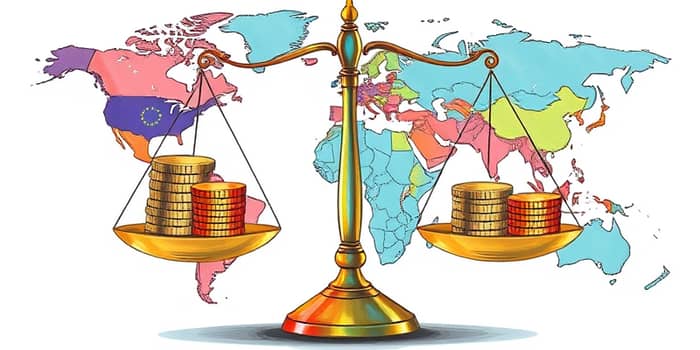
In mid-2025, a palpable sense of relief swept across markets in Europe and Asia. After years marked by record-high borrowing costs and relentless rate hikes aimed at taming inflation, central banks are now easing their grips. On June 5, 2025, the European Central Bank (ECB) surprised observers by cutting its deposit facility rate by 25 basis points—from 2.25% to 2.00%. Not far behind, several Asian central banks have paused their monetary tightening cycles, choosing caution over further hikes in an environment fraught with uncertainty.
This strategic pivot is not merely a technical adjustment. It represents a collective recognition that economies are entering a new phase. With inflationary pressures abating and growth prospects evolving, policymakers are recalibrating their tools to support sustainable expansion without reigniting price spikes. For business leaders, investors, and everyday citizens, understanding this transition is vital to making informed decisions and capturing emerging opportunities.
Two years ago, skyrocketing energy prices and pent-up demand from the pandemic triggered an unprecedented wave of rate hikes across advanced economies. Central banks responded aggressively, raising rates at the fastest pace in decades. But the inflation story has shifted dramatically.
In Europe, headline inflation peaked at over 8% in late 2022. By mid-2025, it has moderated to approximately 2%, aligning closely with the ECB’s medium-term target. This relief stems from multiple factors:
Asia’s landscape is different but equally compelling. In Japan, decades of low growth and deflationary episodes have trained the Bank of Japan to maintain an ultra-accommodative stance. Even as inflation remains below 2%, policymakers are wary of premature tightening that could stifle fragile domestic demand. China and other Asian economies, facing a slowdown in exports and a soft housing market, have paused rate hikes to preserve growth momentum.
Moreover, global trade tensions—particularly between the US and its major trading partners—continue to cast a shadow. Unpredictable tariff regimes and protracted negotiations introduce volatility into export-dependent economies. Against this backdrop, central banks prioritize stability over aggressive tightening.
Though united by the decision to slow or reverse rate hikes, Europe and Asia exhibit unique dynamics shaped by demographics, fiscal policies, and structural factors.
In Europe, there is a clear divergence between northern-export-oriented economies and their southern counterparts. Germany’s manufacturing sector remains resilient, but fragile global demand has led to layoffs and production cuts in key industries. Conversely, Spain and Italy, buoyed by tourism and domestic consumption, are cautiously optimistic yet wary of premature monetary support that could reignite inflationary pressures.
Eastern European nations—particularly those heavily exposed to commodity markets—face higher inflation rates and greater volatility. Their central banks, until recently, lagged behind the ECB in hiking cycles and must now balance the need to maintain competitiveness against inflationary trends imported from global markets.
Across Asia, Japan stands apart with its sweeping demographic headwinds. An ageing population and a shrinking workforce are projected to reduce potential GDP growth to near zero by mid-century. In response, the Bank of Japan has signaled a continuation of its yield curve control program and negative interest rates to encourage lending and investment.
China’s policy calculus is more nuanced. With growth slowing to around 4%, authorities are deploying a mix of fiscal stimulus, regulatory adjustments, and measured monetary easing. Other regional central banks, including those in South Korea and Southeast Asia, are watching global cues and prioritizing exchange rate stability to ward off imported inflation.
Adapting to a gentler monetary stance offers both opportunities and pitfalls. Whether you run a multinational corporation, manage a family enterprise, or oversee an investment portfolio, proactive planning is essential.
Here are key strategies to consider:
The decision to slow monetary tightening is not an endpoint but a strategic inflection. It reflects a nuanced assessment of risks and priorities: containing inflation without choking off growth. Several scenarios could unfold:
Downside risks include a resurgence in geopolitical conflicts, abrupt trade escalations, or a sharper-than-expected slowdown in China. These events could reignite volatility and force central banks to reconsider their easing paths.
Upside opportunities may arise from coordinated fiscal and monetary support. In Europe, the NextGeneration EU fund and green transition spending could catalyze long-term growth. In Asia, structural reforms—such as labor market liberalization and technology-driven productivity gains—offer a pathway out of demographic stagnation.
On a human level, these policy shifts influence employment prospects, borrowing costs for families, and returns on savings. For mortgage holders, even small rate cuts can translate into meaningful monthly savings. For retirees, stable inflation preserves purchasing power. For entrepreneurs, lower financing costs can make the difference between launching an innovative venture or shelving it.
As we navigate this evolving terrain, a few guiding principles stand out:
The pause in monetary tightening offers a rare window of opportunity to reassess, realign, and rebuild resilience. By understanding the evolving context and implementing robust strategies, stakeholders can thrive in a more supportive financial environment.
In the months ahead, the global economy will reveal whether this shift marks the start of a sustained easing cycle or simply a temporary reprieve. Either way, those who blend vigilance with strategic foresight will be best positioned to turn policy changes into progress, innovation, and shared prosperity.
References













